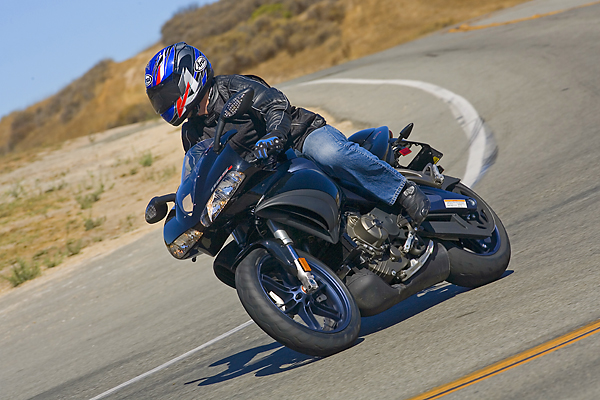
In judging beautiful women, a nice figure and athletic moves are a plus, but a beautiful face is the sine qua non. Without one, you might not be invited to the party.
. . . And so it has been for Buell and its sport bikes. Uninvited. Take a look at any number of open-class sportbike comparison tests published here in the United States or abroad. All the latest and greatest “contenders” are assembled for evaluation, but no Buell can be found amongst them.
In this analogy, a beautiful face is the engine. Although Buell has had the chassis to stand toe-to-toe with any sportbike in the world for quite some time, it has lacked a modern, liquid cooled engine with competitive power. The engine it has used has evolved into an effective complement to its other models, but the sportbike customer generally demands something more cutting edge.

While Buell’s sportbike competitors have been knocking on the 200 horsepower-per-liter door (some claiming to have surpassed it . . . at least, with 600cc inline-fours), Buell has been stretching for 100 horsepower-per-liter from its 45 degree air/oil cooled twin.
As a result, although careful observers appreciate well Buell’s chassis, and its unique, effective engineering solutions, its sportbike competitors can write it off as, on the whole, an anachronism. More significant for Buell, most sportbike customers (yes, the people reading those comparison tests as if they were an over-inclusive shopping list) have never had Buell on their radar screen, much less in their garages.
Buell is not a company known for half measures, however, and when the decision was made to build a modern, liquid cooled v-twin, no corners were cut. BRP-Rotax in Austria was chosen as a development partner for the mill, and its credentials are flawless. Who else shops at Rotax? How about BMW, Aprilia (where its superb Mille superbike v-twin was developed) and notable others.
At the press intro for the Buell 1125R, I spoke extensively with a senior Rotax engineer about the new Buell’s engine, and the words “state of the art” came out of his mouth so often, I began to think he had a strange form of Tourette Syndrome. When Buell pulled the trigger on a new design, they obsessively pursued every ounce of power and efficiency . . . “Hey, if we run a skinnier spark plug, we can increase the valve area even more!” “Even though our engine has larger displacement, let’s make sure it is lighter than a Ducati 1098 engine.” And so on.
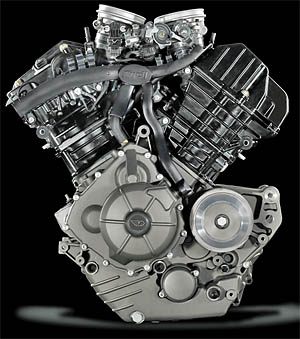
The 1125R Helicon engine displaces 1125cc. It is configured as a 72 degree, v-twin. The engine was designed and engineered specifically for Buell, and is rated at 146 crankshaft horsepower (without Ram air . . . Ram air adds a claimed 5 hp). One of the Rotax engineers I spoke with said the 72 degree v-angle helps centralize mass, and provide more weight distribution options (the 1125R has 54% of its weight on the front tire), but still allows for a very straight intake tract. Ducatis are 90 degree v-twins, of course, and Aprilia’s Mille features a 60 degree angle — a very tight and compact engine, but one that requires compromises in terms of intake tract design. 72 degrees seemed like a good compromise to Buell and the Rotax engineers.
The 72 degree angle of the v-twin also helps reduce vibration, because it is closer to the perfectly balanced (in terms of primary vibrations) 90 degree layout. Since the engine is rigidly mounted as a stressed member of the chassis, Buell took the extra step of fitting three balance shafts — two to reduce any remaining primary vibrations, and a third to balance the rocking motion generated by the v-twin power pulses.
According to Buell, the idea for 1125cc of displacement was arrived at by first looking at the torque and horsepower curves Buell wanted to achieve. You have to remember that three years ago, when development of this engine was in its early stages, v-twin displacement limits for superbike racing (WSB and otherwise) sat at 1000cc, and there was no displacement increase on the horizon. I believe it when Buell says it designed this engine with the customer in mind, not racing.
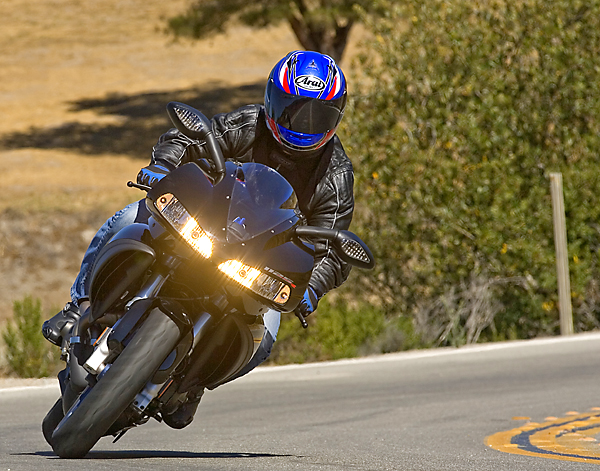
The dyno charts that Buell showed us indicate a very flat torque curve, with near peak torque numbers beginning just above 4,000 rpm and extending well beyond the 82 foot pound peak at 8,000 rpm. This means the powerband is huge (which our riding confirmed, with two gears seeming to be equally effective on many corner exits).
The valves (four per cylinder) are actuated by finger followers and adjusted with shims. This design reduces friction and eliminates valve float. It also complements the extremely steep valve angle and down-draft fuel injection system. Valve covers are made of magnesium for reduced weight. The engine is also a dry sump design, with an integrated oil reservoir placed low on the left side of the crank case.
The fuel injection system features 61mm throttle bodies, and the huge, 12 liter airbox is pressurized by a Ram air system fed by an intake located between the fork legs and below the fairing. Computer analysis told Buell engineers this would be the ideal spot to locate the Ram air intake consistent with the other air management goals of the 1125R design.
Twin radiators are located on each side of the engine longitudinally inside their own cowlings. Among other things, Buell claims this design allows hot air to be exhausted away from the rider.
The muffler is located beneath the engine, a location now popular with many manufacturers, but common with Buell bikes for years. Buell claims very high flow (negating any advantage from most aftermarket exhaust systems) with reasonable sound levels. The bike proved to be reasonably quiet during our testing.
One of the most interesting engineering solutions employed by Buell in the new 1125R involves the clutch. At first glance, it is a conventional hydraulically-actuated system, but there is a unique vacuum assist occurring in the background. This not only reduces clutch pull effort at the lever, it works as a “slipper” clutch on aggressive downshifts. The source of the vacuum is ports on the intake manifolds. We were really impressed with how well the clutch worked (particularly, the “slipper” effect) during our testing. More about that below.

Another seemingly unique, and intelligent engineering solution incorporated in the Helicon motor is the cush drive located forward on the drive sprocket, rather than on the rear wheel. This is just one way Buell minimizes unsprung weight and centralizes mass. Buell also attacks unsprung weight with belt drive (roughly 1/4 the weight of a typical drive chain) and the now familiar ZTL (Zero Torsional Load) front brake with massive disc attached directly to the rim (rather than the hub, as is the case with competitors’ motorcycles). On the 1125R, this disc is pinched by a single, eight-piston caliper through four separate pads. That single rotor measures 375mm, which contributes to a system that allows a much lighter front wheel (due to the lack of force at the hub) and an overall weight reduction of several pounds compared to other modern sportbike designs. The rear brake rotor measures 240mm, and is gripped by a two piston caliper mounted directly to the swingarm. Braided steel brake lines are standard.

Buell, already known for its incredibly stiff chassis on other models, designed an all-new chassis for the 1125R. It is claimed to be the stiffest chassis ever designed by Buell, and is aided in its rigidity by utilization of the smooth engine as a stressed member. A new swingarm design pivots directly in the engine cases to further increase rigidity and provide quicker, more direct response to front wheel steering inputs at the back of the bike.

Showa suspension units are fully adjustable at both ends of the motorcycle. The 47mm inverted forks are huge, and extremely stiff (to complement the chassis), while the rear shock is mounted directly between the frame and the swingarm (without linkage) slightly off-center to optimize air flow through the motorcycle. Like several other Buells, fuel is housed in the aluminum frame spars. The 1125R carries 5.6 gallons.
Compared to most modern sportbikes, the 1125R exposes more of its engine, and offers an aggressive, semi-naked look. The unique, broad front fairing is intended by Buell to optimize air flow characteristics, reduce drag and keep the rider comfortable.
We did not ride the bike at night, but the six-bulb headlight system is reportedly very bright. LED turn signals (with the fronts housed with the mirrors) complement the lighting system.
The 1125R also has a somewhat more upright riding position than other modern sportbikes. Despite this, we found wind protection from the unique fairing design quite impressive, with very little buffeting and very good coverage of the upper arms and shoulders.

Front brake and clutch levers are adjustable for reach, while rear brake and shifter foot controls can be adjusted to accommodate different rider foot size.
Instrumentation includes a large analog tach, digital speedo, lap timer with splits, ambient air temperature, coolant temperature, dual trip meters, current miles per gallon, average miles per gallon and low fuel indicator.
We tested the new 1125R in Northern California over two days. The first day was spent riding a variety of public roads, including both tight canyons and open highways. On day two we rode at world famous Laguna Seca Raceway.
The 1125R has that trademark Buell chassis feel . . . rock solid. Riding the bike aggressively on the street in tight canyons at a rapid pace underscored the massive chassis rigidity Buell has achieved in the 1125R design. While allowing some lateral flex to deal with road imperfections when the bike is leaned on its side, Buell focuses intently on minimizing torsional flex.

I commented to one of the Buell engineers after the first day that the bike seemed to react instantly to steering inputs, without any perceptible chassis “wind up”. From the front axle through those huge 47mm fork tubes, steering inputs seem to travel without hesitation to the rear wheel via the massively braced, torsionally stiff design.
As I said earlier, Buells have been known for their handling prowess, and the 1125R has only taken that reputation a step forward. What is new here is the smooth thrust provided by the incredible engine Buell and Rotax have collaborated on.
The Helicon engine is a weapon. That high plateau of torque spread almost evenly over several thousand rpm launches the 1125R out of corners right now . . . while many higher strung, four-cylinder bikes might just be starting to search for their powerband. It does this in a smooth, controlled manner that allows the rider to open the throttle more aggressively and earlier without upsetting chassis balance or risking rear wheel spin.

The bikes we tested were pre-production units, and they did have some quirks. Throttle response below 4,000 rpm was less than smooth, and could complicate pulling away from a stop. Above 4,000 rpm, throttle response was excellent, and for this rider the fuel injection set up never presented an issue once the bike was moving. Nevertheless, Buell says it is still working on its fuel injection mapping, and that low rpm fueling should improve before production models leave the factory later this year.
I rode several different bikes over the two days, and one of them ran roughly 12 degrees hotter (in terms of engine temperature) than the other machines — something I confirmed with other riders in my group as we came to stop lights. This bike transmitted a fair amount of heat through the frame spars to my legs. Despite running a different bike much harder on Day 2 (on the track), I did not experience this same heat discomfort. I would hope that this is not an issue with any of the production models.

The rear shock seemed to be sprung a bit more stiffly than the fork. When the bike was ridden aggressively, the shock seemed to do its job well, but there was some harshness transmitted by square edged bumps while cruising around. This was not a big issue for me, and overall, I considered the suspension settings on the pre-production units excellent for the intended purposes of the bike.
In fact, the fork settings seemed outstanding, and the bike as a whole was well balanced — exhibiting very little squat or dive, for instance.
Our day at Laguna Seca Raceway underscored the handling prowess of the 1125R. This bike really loves to carve corners, and remains relatively flat and stable on corner entry (hard on the brakes) and exit (hard on the gas).
The clutch worked flawlessly at the track. It was almost impossible to upset the 1125R’s chassis with aggressive downshifts. I can’t say that the vacuum assist method employed by Buell is better than a more traditional “slipper clutch” design, but it is easily as effective as any other slipper clutch I have used.
The new six-speed transmission designed for the 1125R operated excellently throughout our testing. Gear changes were smooth and positive, and shifting up without the clutch was not a problem.
The front brake was outstanding — both on the street and on the track. We never experienced any fade, while power and feedback were excellent. The rear brake was perhaps a bit too strong, at times, but it was relatively rare that I found it upsetting my corner entry.
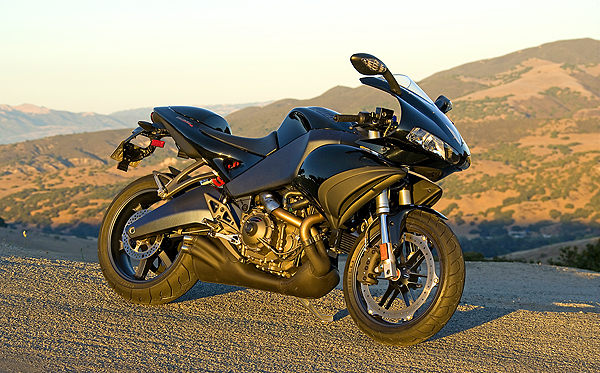
The more upright ergos were not a hindrance on the race track, and were a very welcome comfort on the road. The 1125R is not a sport tourer, but it is just as comfortable as some sport tourers I have tested, and far more comfortable than most sportbikes.
I don’t know if it was the extra wide fairing at work, but the cockpit area was undisturbed by sudden wind buffets. The wind that is allowed to reach your upper shoulders and head is smooth.
The instrumentation is reasonably legible, and was something I didn’t really think about too much (generally, a good thing).
Laguna Seca also drove home another very important point concerning the new Buell 1125R. This bike is fast . . . viciously fast. Like some other v-twins, it accelerates in a somewhat deceptive manner, but with roughly 80 pound feet of torque available over a very broad sweep of the tachometer, this 375 pound machine (claimed dry weight — 421 pounds ready to ride without fuel) sucks up straightaways in a hurry.
It is always difficult to compare a machine to its competitors without back-to-back riding, but let me say this. If Buell isn’t invited to the open-class sportbike party this year, it may just show up and kick the door down.
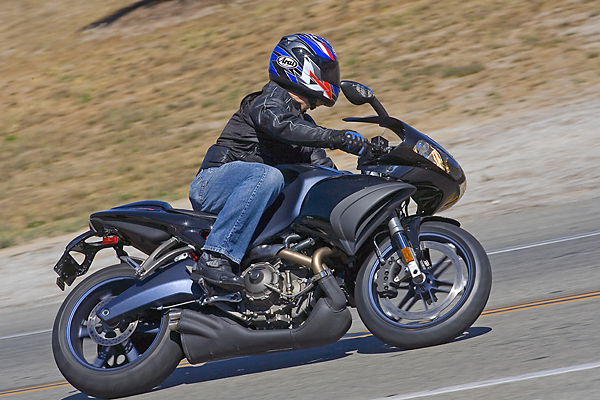
When the 1125R becomes available in the U.S. later this year, the MSRP will be $11,995. The only color available for 2008 is shown in the photos — Midnight Black bodywork, with Diamond Blue frame, swingarm and wheels. For additional details and specifications, visit Buell’s web site here.





